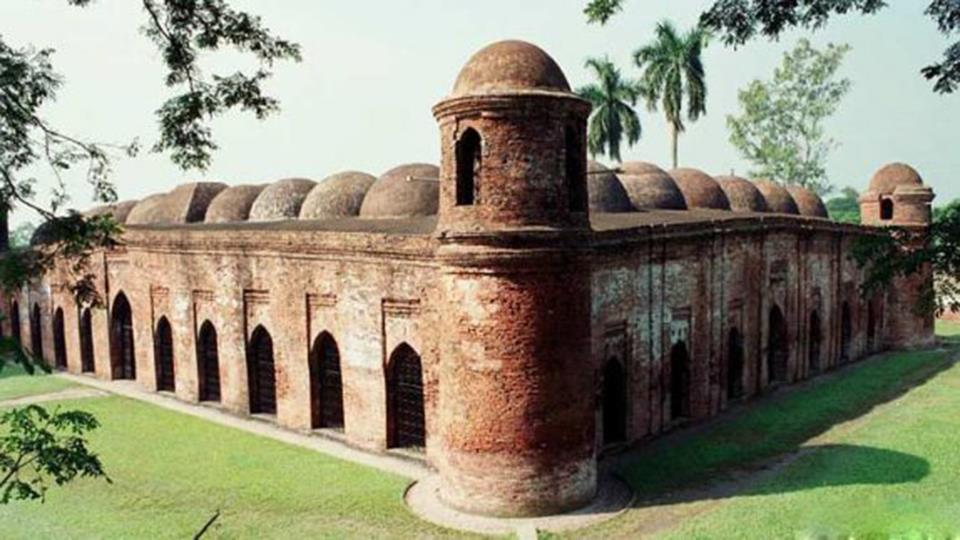
Bagerhat : Town Of Mosques, Monuments
Known for the UNESCO World Heritage Site the' Sixty-Dome Mosque'- Bagerhat town was founded in 15the century, by Muslim General turned Saint Khan Jahan Ali. He moved to Bagerhat from Barobazar in Jhenidah district.
Bagerhat was the capital of Hazrat Khan Jahan Ali - the 15th- century pioneer of the Sundarbans region of the southern Padma River (Ganges [Ganga] River) delta - and contains the ruins of his mausoleum and a large mosque (Sat Gumbaz; built c. 1459).
At the time of his reign, Bagerhat was a part of the Sundarbans. He cleared the forest and made it habitable. He named it 'Khalifabad'. He erected many official buildings to run his administration. He also built many mosques and dug tanks. The buildings erected by him are now all in ruins.
Located at the confluence of two rivers, the Brahmaputra River and the Ganges, Bagerghat is also known as the Mosque City for the presence of a large number of mosques in the district. The domed structures of the mosques built with bricks in the 15th century are considered an architectural marvel.
It is bounded by Gopalganj District and Narail District on the north, The Bay of Bengal on the south, Gopalganj District, Pirojpur District and Barguna District on the east and Khulna District on the west. Main rivers of the district are Panguchi, Daratana, Madhumati River, Pasur River, Haringhata, Mongla River, Baleshwar, Bangra and Goshairkhali.
The town and its surroundings have more than 50 monuments based on the Indo-Islamic architecture, this area went into atrophy for quite some time. It was only decades ago that this city came into the fore and grabbed the global attention, further getting the tag of UNESCO World Heritage Site.
While the city is an epitome of architectural ensemble, the Sixty-Dome Mosque and shikhara-style Hindu temple called Kodla Moth or Ojoddha Moth has emerged to catch everyone's attention and imagination for its superb structure. The mosque, built with 60 pillars and 77 domes, is alluring and it takes you a flight back to the past.
This historic city was left only to be shrouded by the jungle after the death of its founder, Khan Jahan Ali. Bagerhat city's claim to fame is the density of Islamic monuments. What is striking is the city has no fortification against any potential enemy invasion around it for impenetrable mangrove swamps of the Sundarbans. What is more, the quality of physical infrastructure like roads, bridges and reservoirs reveal perfect technical mastery.
The grandeur of numerous mosques and other infrastructure in Bagerhat town bear testimony to hard work and efficient technical skills and engineering marvels shown even during the 15th century when technology had been in its infancy. Almost all the Islamic monuments are built of brick. While the mosques stand out, the city also included mausoleums, bridges, water networks, and buildings for public gatherings.
In addition to the iconic Sixty-Dome Mosque, there are other interesting places and attractions that are sure to arrest your attention. The places are Sona Mosque, Durgapur Shiva Ground, Ghora Dighi, Mongla Port, Rupsha Bridge and Kodla Ground, to name but a few.
The mosque city will take you on an architectural tour. More of a long-forgotten leaf from some old book, this place will make you realise what would have gone missing if left undiscovered. The world-famous Forbes magazine enlisted Bagerhat in 2011 as one of the 'Fifteen Lost Cities of the World' alongside awe-inspiring sites such as Machu Picchu, Pompeii and Angkor Wat. You would truly miss out if you do not lay eyes on this city and experience the splendours that truly honour its appellation 'The Mosque City of Bagerhat'.
Bagerhat is no less in terms of natural beauty. A ride along the district's prime river Bhairab reveals to travellers on either shore the blinding lushness as if painted green by an over-enthusiastic child. Bagerhat possesses a laid-back atmosphere with its key attractions lying at close proximity.
Bagerhat experienced a whole new perspective when travellers chose to stroll down its primary road along the Bhairab, pausing periodically for a chit-chat over a cup of tea. You might even learn a thing or two about the people, their lives and their resilience in the south, and the astonishing stories of how they battle every day with high salinity, floods and the slow destruction of the world's largest mangrove forest, thus making climate-vulnerable.
Despite having potentials of being an attractive tourist destination-for both local and foreign-Bagerhat is yet to get the kind of attention it deserves. By visiting these places, tourists can get an insight into the glorious past of the town and also admire the architectural marvels that have been there for antiquities.
Legal Disclaimer:
MENAFN provides the information “as is” without warranty of any kind. We do not accept any responsibility or liability for the accuracy, content, images, videos, licenses, completeness, legality, or reliability of the information contained in this article. If you have any complaints or copyright issues related to this article, kindly contact the provider above.






















Comments
No comment